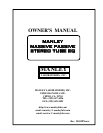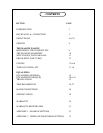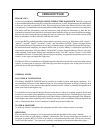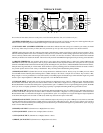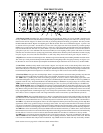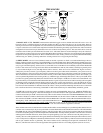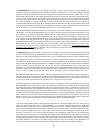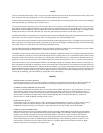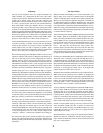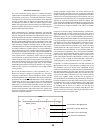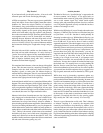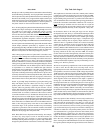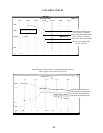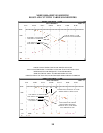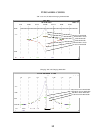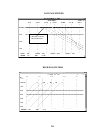
4) BANDWIDTH. Similar to the "Q" control found in many EQs. A more accurate term here would be "Damping" or
"Resonance" but we used "Bandwidth" to stay with Pultec terminology and because it is a "constant bandwidth" (*) design
rather than "constant Q" and because of the way it uniquely works in both Bell and Shelf modes. In Bell modes, you will
find it similar to most Q controls with a wider shape fully CCW and narrower fully CW. The widest Q (at maximum boost)
is about 1 for the 22-1K band and 1.5 for the other 3 and the narrowest Q is about 2.5 to 3 for all of the bands and most of
the frequencies. On paper, the bell widths appear to have less effect than is apparent on listening and the sound is probably
more due to "damping" or "ringing" and the way it interacts with the gain. Also some people associate a wide bell on
conventional EQs with more energy boost or cut, and at first impression the Massivo seems to work backward compared with
that and narrow bandwidths give more drastic results. On the Massive Passive a narrow bandwidth bells will allow up to the
full 20 dB of boost (or cut) and wide bandwidths significantly less at about 6 dB maximum.
In Shelf Modes the Bandwidth has a special function. When this knob is fully CCW, the shelf curves are very similar to almost
all other EQs. As you increase the Bandwidth control, you begin to introduce a bell curve in the opposite direction. So if you
have a shelf boost, you gradually add a bell dip which modifies the overall shelf shape. At straight up, it stays flatter towards
the mid range, and begins to boost further from the mids with a steeper slope but the final maximum part of the boost curve
stays relatively untouched. With the Bandwidth control fully CW, that bell dip becomes obvious and is typically 6dB down
at the frequency indicated. The boost slope is steeper and the maximum boost may be about 12 dB. These curves were
modelled from Pultec EQP1-As and largely responsible for the outrageous "phatness" they are known for. As you turn the
Bandwidth knob (CW), it seems as if the shelf curve is moving further towards the extreme frequencies, but mostly of this
is just the beginning part of the slope changing and not the peak. This also implies, that you may find yourself using
frequencies closer to the mids than you might be used to. These shelf curves have never been available for an analog high
shelf before and provide some fresh options.
5) FREQUENCY. Each band provides a wide range of overlapping and interleaving frequency choices. Each switch
position is selecting a different capacitor and inductor. Only the 22 and 33 Hz on the low band and the 16K and 27K in shelf
mode deserve some special explanation. These have been "voiced" a little different from the rest and are somewhat unique.
Why "modify" the way the 22, 33, 16K and 27K shelves work? When we specify that a low shelf is at 22 Hz, it means that
only the half-way point of the boost (or cut) is 22 Hz. If we dial up a 20 dB boost set at 22Hz then 22 Hz is half-way up
the slope or boosted 10dB. The full amount of the boost (20 dB) is only kicking in around 2 Hz. This is dangerous and almost
useless for anything except whale music. Not only that, but now we have a Bandwidth control that seems to push the
frequency lower, and at 12:00 essentially flattens the EQ at 22Hz. So we changed the Bandwidth control for those two lowest
frequencies so that it acts as a HP filter as you turn it CW and tends to prevent boosting excessive sub-sonic frequencies. To
our ears, it seems to "tighten up" the shelf and removes some of the sloppy looseness associated with those sub-sonics.
The 16kHz and 27kHz shelfs were also specially "voiced" for similar reasons. In this case, a 50kHz low pass filter prevents
these shelfs from helping recieve the local AM radio stations. The Bandwidth-Dip frequencies were lowered to about 8 kHz
so that on a single band, you would have more effective control between the balance of "air" and "sibilance". In practice, it
gives you a great deal of air without the usual problem "esses" when you boost a lot of highs.
At extreme high and low frequencies (including 10K and 12K), you might get some unexpected results because of the
Bandwidth/Shelf function. For example, you can set up 20 dB of boost at 12K and it can sound like you just lost highs instead
of boosting. This happens when the Bandwidth control is more CW only and not when it is CCW. Why? You are creating
a dip at 12K and the shelf is only beginning at the fringes of audibility but the dip is where most of us can easily percieve.
It takes a little getting used too the way the controls interact. The reverse is also true, where you set up a shelf cut and you
get a boost because of the Bandwidth control being far CW. In some ways this simulates the shape of a resonant synthesizer
filter or VCF except it doesn't move. These wierd highs are useful for raunchy guitars and are designed to work well with
the Filters. There are a lot of creative uses for these bizarre settings including messing up the minds of back-seat engineers.
There is some example settings near the back page that may help to show how different this EQ is.
_________________________________________________________________________________________________
* For the technically minded, there is another and stronger definition of "constant bandwidth" filters but it doesn't seem to
apply to pro audio. In FM radio recievers "constant bandwidth" is a type of filter used in the tuning sections, and the filter
width allows the reception specs to stay constant as the tuning filter is moved. It is unlikely anybody has ever offered this
type of constant bandwidth filter lowered to audio frequencies. Given that we have about 3 decades of frequency in audio,
can you imagine an EQ that had a Q of 0.3 (very wide) in the lows and a Q of 30 in the highs (extremely narrow)? For
perspective, a Q range of 1 to 10 is a pretty wide span. There are a few EQs that get slightly narrower Qs as the frequency
is increased but not even close to true "constant bandwidth" the RF engineers appreciate. This is either deliberate or the result
of trying to squeeze too much range out of a simple inductor. Manley Labs prefers the bell shape to remain relatively constant
at all frequencies and the Massivo uses 14 tap inductors with low DCR to provide this. The only possibly useful "Q variation"
(other than a Q knob) is a circuit that gives a wider Q for boosts and a narrower Q for cuts. This very rare technique is cool
for music. It corresponds to the way many engineers use EQs and reduces audible ringing and EQ "signature".
7



